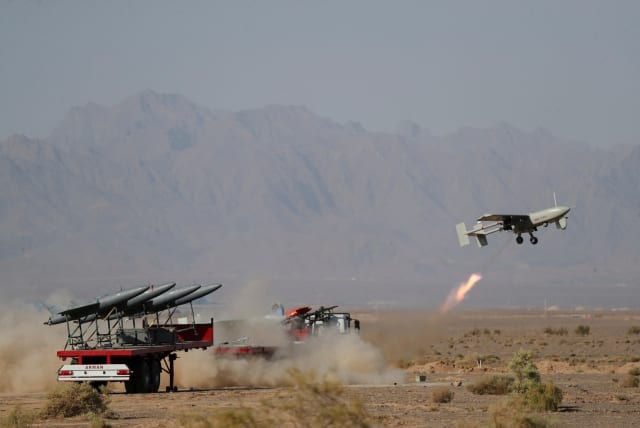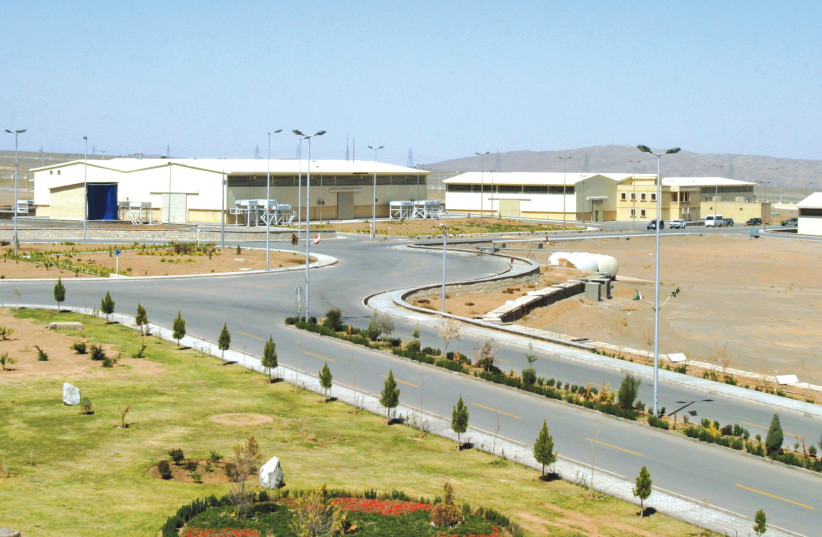Gantz: Iran conducted 16 separate attacks in past 5 years in the Gulf and Red Sea

“We are reminded that war is not a distant reality and that countries must be able to build their capabilities and defend themselves."
Iran has conducted at least 16 separate attacks on international vessels in the Gulf and Red Sea in the past five years and can reach a significant quantity of enriched uranium for one nuclear bomb (SQ1) at 90% in only two weeks, Defense Minister Benny Gantz said Thursday.
“Just this month we saw an attack on a commercial vessel using a Shahed 136 UAV, which was launched from the Chabahar region of southern Iran,” Gantz said. This is the same area I discussed a year ago with your ambassadors, as a hotspot of terrorism. In fact, in the last five years, Iran has conducted at least 16 separate attacks on civilian international vessels in the Gulf and the Red Sea.”
Gantz, who made the comments during a security briefing for defense attaches of over 30 countries, stressed that the Islamic Republic is not only a threat to Israel, but poses a challenge to the region and the world.
“Iran continues to build, expand and fortify its capabilities. Today should Iran decide to do so, it may reach SQ1 at 90% enriched Uranium in only two weeks. The international community must take action – strengthening alliances, increasing intelligence cooperation, projecting power and responding forcefully to Iranian attacks and aggression.”
Simulations in place

This week, in a message to Iran, the IDF and US military held a series of joint exercises, including simulating various scenarios against the Islamic Republic.
During the four-day-long drill, Israeli F-35 stealth fighters accompanied four American F-15s and an American KC-135 refueling aircraft that refueled a number of IAF F-16s. The IAF also practiced long-range operational flight scenarios.
The IDF Intelligence Directorate also took part, holding an extensive simulation replicating a campaign against countries far from Israel’s borders, testing the military’s intelligence gathering capabilities, target determination and outlining, as well as making intelligence available to operational forces.
At the same time, the US Fifth Fleet is in the midst of a three-week-long unmanned and artificial intelligence integration exercise, with 15 different platform types, including 10 new platforms (including Israeli) being deployed in the region for the first time.
Dubbed “Digital Horizon,” the Fifth Fleet hopes to advance its “efforts to integrate new unmanned technologies while establishing the world’s first unmanned surface vessel fleet by end of next summer,” read a statement by the 5th Fleet. the “US Fifth Fleet’s efforts are focused on improving what US and regional navies are able to see above, on, and below the water.”
Since Israel moved to CENTCOM’s area of responsibility, there have been numerous joint drills between the IDF and American forces in the region.
“Since the signing of the Abraham Accords and Israel’s move under the CENTCOM umbrella, there have been over 200 interactions between Israeli officials and regional partners,” Gantz said Thursday, adding that in the last two years, around 140 defense agreements and groundbreaking MOUs have been signed between Israel and partner countries.”
The briefing, where the outgoing defense minister thanked the attaches for the strengthening of defense and industrial ties between Israel and the various countries, was attended by the Director of the Policy and POL-MIL Bureau Dror Shalom and the Head of the IDF’s Strategic Division, Brig.-Gen. Oren Setter.
Touching on the ongoing war in Ukraine, which Israel has been criticized for not sending offensive weaponry, Gantz stressed that Jerusalem continues to stand and support Kiev and condemns all direct attacks against the country’s civilians.
“We are reminded that war is not a distant reality and that countries must be able to build their capabilities and defend themselves. At the same time, alliances must be strengthened in order to ensure regional and global stability.”
Israel has sent humanitarian aid as well as medical equipment but refuses to send any weaponry that can be deemed lethal, including air defense systems. Israel is also reported by foreign media to be helping with intelligence but it is concerned that any advanced weaponry that could be supplied might end up in the hands of Iran.
Gantz has spoken with his Ukrainian counterpart Oleksii Reznikov twice over the past month and offered to assist the war-afflicted country in developing a civilian early-warning system.
“This is an ongoing process,” he said.
Kyiv continues to push Jerusalem to supply it with offensive weaponry as it is being battered by Russian missile strikes and attacks by Iranian-made drones that Tehran has supplied to Moscow.
Jerusalem Post Store
`; document.getElementById("linkPremium").innerHTML = cont; var divWithLink = document.getElementById("premium-link"); if (divWithLink !== null && divWithLink !== 'undefined') { divWithLink.style.border = "solid 1px #cb0f3e"; divWithLink.style.textAlign = "center"; divWithLink.style.marginBottom = "15px"; divWithLink.style.marginTop = "15px"; divWithLink.style.width = "100%"; divWithLink.style.backgroundColor = "#122952"; divWithLink.style.color = "#ffffff"; divWithLink.style.lineHeight = "1.5"; } } (function (v, i) { });
